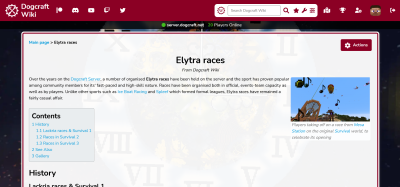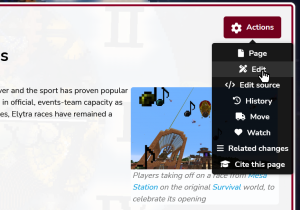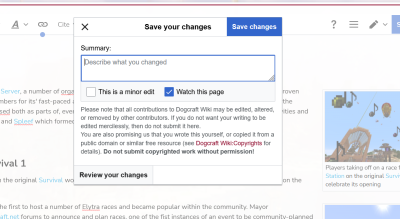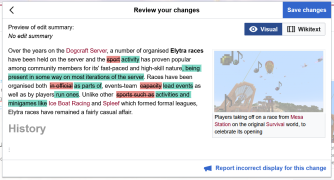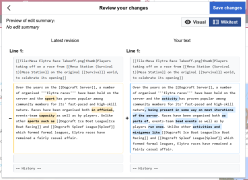Help
Your first edit
From Dogcraft Wiki
This is part 1 of the series of editing guides of the Dogcraft Wiki. This guide is a step-by-step process to your first edit - or, how to edit plain text with the visual editor.
Requirements
This guide is made from the perspective of a a logged-in user with default preferences. You need to log in to edit a page, which you can do using the Login button in the top right side of the red top-bar.
Walkthrough
1. Spotting an error
Finding an error to fix can sometimes be hard, but there are always pages that can be improved; the wiki will never be perfect. Let's assume you've found a page with something simple to fix (e.g. just something in the text). I have found such an example for this demonstration: the Elytra races page introduction is a bit outdated, I'm going to reword it.
2. Opening the editor
Opening the editor is simple; just hover the Actions button at the top right corner of the page and click the Edit option.
You are now in the editor. It looks like the page, but some bits may move around, and there's an edit toolbar at the top. This editor is called the VisualEditor, a WYSIWYG (what you see is what you get) editor. It behaves like any word processor (e.g. Microsoft Word). Feel free to click around and explore the parts of a page and what they look like when left-/right-clicked.
3. Editing the page
Now, I'm just going to edit the introduction. This bit is just plain text with no additional stuff; so to edit it, we just select where to type, and type there. You can select text to copy, paste, delete, etc. A new paragraph can be created by pressing enter.
Here's my finished reword. It may not be perfect, but it should be more readable and clear.
4. Saving the edit
Saving an edit is done by clicking the 'Save changes' button on the right side of the toolbar. Click it to open the save dialog.
In the dialog there's a textbox to put an edit summary, and three buttons. First, we're going to check the 'Review your changes' button.
- Reviewing changes
Changes are shown to you as a diff (which you may be familiar with if you use tools like git) either in Visual or Wikitext mode.
In visual mode, the text highlighted in red is the currently viewable page, and the text highlighted in green is as you've changed it. In wikitext mode the left column of text (with the green theme) is the currently viewable page, and the right column (with the blue theme) is the text as you've changed it. Lines with something that has changed have a thick left border, and lines with nothing changed are flat grey. Text that was added, changed, or removed is highlighted in green on the left, and the replacement (and new) text is highlighted in blue on the right. This text is in a markup language known as wikitext (covered in greater detail with later guides).
What we're looking for is twofold: double check our changes are what we want to do (proofread it), and see if anything has changed that should not have changed. The VisualEditor has persistent bugs that can cause it to insert/delete some extraneous text. If you notice this has happened to you, it may be possible to fix it by using source mode (see source mode introduction guide); however, you might have to start the edit over. Luckily, our example edit seems fine so we'll continue.
It is optional but recommended to do this for every edit.
- Saving
Clicking Return to save form brings us back to the previous form. Here we're going to add an edit summary and finally save the page.
An edit summary is a comment attached to your edit that isn't visible on the page itself, but is publicly viewable when looking at the changes that have been made. You should try to succinctly summarise your edit so that other editors can see what you've done. You can be as brief or descriptive as you like, but bear in mind there is a 255 characters limit. You can also use wikitext links in edit summaries, if you like. Edit summaries also get sent to the wiki Discord, along with who made them. Edit summaries can't be changed after the fact, only deleted by an administrator (and only within certain criteria).
I've gone with simply describing the edit as "rewritten introduction".
Now, we just click save. After a short time (don't close or reload the page during this; your edit may be lost if you do!), the edit is saved and the page automatically reloads to show the newest version of your page.
And that's it! The edit has been saved and is viewable to all.Common things to fix and not fix
There are several simple things you should fix if you see them, for example:
- Typos
- Links to incorrect places
- Incorrect or outdated information
- Poorly-formatted/worded paragraphs
Things you should bear in mind:
- When talking about dates or times, using words like "evening", "spring", "morning", etc. only makes sense in the region you live in. (Noon in Africa is morning in America, summer in Europe is winter in Oceania, etc.) Specify timezones when talking about times and something relative to the calendar like months or "the middle of the year" when talking about dates.
- See the Project:Guidelines for more details.
See also
- The next guide in the series is Help:VisualEditor basics, about using the VisualEditor to edit various other parts of an article. You may prefer to skip straight to source mode with Help:Source mode basics.
